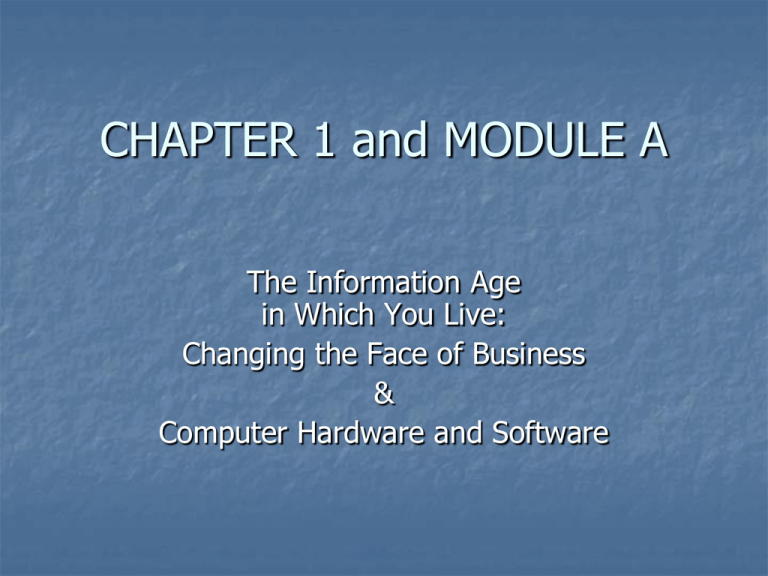
CHAPTER 1 and MODULE A
The Information Age
in Which You Live:
Changing the Face of Business
&
Computer Hardware and Software
Why do we need to Study MIS?
INTRODUCTION
Information age
Knowledge worker
Outnumber all other types of workers at
least four-to-one
IS YOUR SOCIAL SECURITY
NUMBER WORTH $98?
Information technology has greatly accelerated
both the “good” and the “bad”
IT can be used to increase profit, reduce costs,
increase service quality, and benefit society
IT can also be used to steal your personal
information, commit fraudulent acts, etc
Many sites on the Web are – right now – selling
your personal information
What Your Personal Information
Is Worth?
$490 – credit card number and PIN
$147 – driver’s license number
$147 – birth certificate
$6 – PayPal logon and password
$78-$294 – billing data including account
number, address, birth date, etc
Business Must Drive Technology
INTRODUCTION
You live in a digital age
Average American relies on more than 250
computers per day
45 of the 2008 Fortune 500 companies were IT
companies
MIS – Management Information Systems
INTRODUCTION
Telecommuting
Telecommuting
Advantages?
Disadvantages?
Who can telecommute?
Who cannot telecommute?
Three Key Resources
1.
2.
3.
Information
People
Information Technology
Information Resource
Intellectual asset hierarchy – data,
information, business intelligence,
knowledge
Data
Information
Business Intelligence (BI)
Knowledge
Information Resource
Information is
often aggregated
data that has
meaning such as
average age,
youngest and
oldest customer,
and a histogram
of customer ages
Your age – a piece of data
Information Resource
Business intelligence (BI) – collective
information about…
Customers
Competitors
Business partners
Competitive environment
BI can help you make important, strategic
decisions
Information Resource
BI often combines multiple sets of information – customers, salespeople,
and purchases in this case.
Information Resource
Knowledge – broad term that can
describe many things…
1.
2.
3.
4.
Contextual explanation for business
intelligence
Actions to take to affect business intelligence
Intellectual assets such as patents and
trademarks
Organizational know-how for things such as
best practices
Information Resource – Quality
Attributes
Timeliness
When you need it
Describing the right time period
Location (no matter where you are)
Form (audio, text, animation, etc)
Validity (credibility)
Information Resource –
Organizational Perspective
Organizational Dimensions of
Information
Information flows
Upward
Downward
Horizontal
Outward/Inward
Organizational Dimensions of
Information
Information granularity – extent of
detail within the information
Lower organizational levels?
Higher organizational levels?
Organizational Dimensions of
Information
Internal
External
Objective
Subjective
People Resource
People are the most important resource in
any organization, with a focus on
Technology literacy
Information literacy
Ethical responsibilities
People Resource
Technology-literate knowledge worker –
Information-literate knowledge worker
knows how and when to apply technology
Can define information needs
Knows how and where to obtain information
Understands information
Acts appropriately based on information
Ethics – principles and standards that guide
our behavior toward other people
People Resource - Ethics
You always want
your actions to fall in
Quadrant I – both
ethical and legal.
Information Technology
Resource
Information technology (IT)
Two categories of technology
Hardware
Software
Information Technology –
Hardware and Software
Information Technology –
Hardware
1.
Input device
2.
Output device
3.
Storage device
4.
CPU
5.
Telecommunications device
6.
Connecting devices
Six Categories of Hardware
Keyboard
(input)
CDs (storage)
Video card
(connecting)
CPU
Cable modem
(telecommunications)
Monitor (output)
APPA-27
Information Technology –
Software
Two types of software:
1.
Application software
2.
System software
Operating system software
Utility software
Common Input Devices
Common Output Devices
Common Storage Devices
Dinosaurs
Connectors and Ports
Decentralized Computing, Share
Information, & Mobile Computing
Decentralized Computing
Decentralized computing – an
environment in which an organization
distributes computing power and locates it
in functional business areas as well as on
the desktops of knowledge workers
Shared Information
Shared information – an environment in
which an organization’s information is
organized in one or more central locations,
allowing anyone to access and use it as he
or she needs to
Necessary because businesses are greatly
internally integrated today
Mobile Computing
Mobile computing – broad general term
describing your ability to use technology
to wirelessly connect to and use centrally
located information and/or application
software
IT SYSTEMS IN SUPPORT OF
BUSINESS
Competitive advantage
Use technology for
Operational excellence
Major business initiatives
Decision making
Organizational transformation
Systems Support
Online transaction processing (OLTP)
Online analytical processing (OLAP)
Systems
Transaction processing system (TPS)
Customer self-service system OR
Customer Integrated System
Systems
Management Information System
Types of Reports
Periodic
Summarized
Exception
Comparative
Ad hoc
Systems
Collaboration System OR Workgroup Support
System
Groupware
Team dynamics
Group scheduling software
Electronic meeting software
Videoconferencing software
Whiteboard software
Document management
Applications development
Systems
Decision Support System
Artificial Intelligence
Executive information system (EIS)
Executive Information System
(EIS)
In Class Team Assignment
Fresh out of college, our first job is working for the
Alfredson’s grocery food store chain at their
headquarters. As marketing analyst, we are asked to
determine what is the best way to position the different
cereal items on their shelves, so as to maximize revenue
(to maximize revenue, we would like to sell expensive
cereals more than cheap ones, and we would also like to
increase the overall amount of cereal bought by the
public).
What items of information would we need to track, and for
how long, to determine cereal positioning strategies?
3-44
Management Information Systems
for the Information Age
Copyright 2004
The McGraw-Hill
Companies, Inc.
All rights reserved






